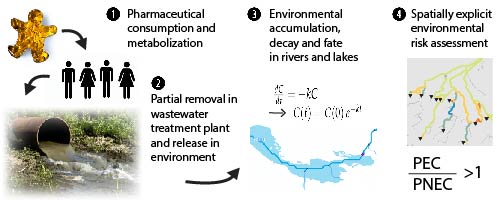High-Resolution Large-Scale Fate modeling
Pollutants from municipal sewage treatment plant effluents are a major source of environmental contamination of global aquatic waterways. Particularly substances from consumer products are of increasing concern. Geospatial risk assessment, the combination of spatially explicit hydrological models with environmental risk assessment methodologies, has been shown to improve traditional environmental risk assessments, by identifying contaminant pathways and predict environmental concentrations under various hydrological scenarios. We developed a new geospatial contaminant fate model capable of predicting chemical concentrations for a variety of substances from consumer products at scales and with a suitable accuracy to support screening and decision making. The model follows simple, well established methodologies, but is unique in its cross-border, seamless hydrological and geospatial framework.As an integrated model the model can help to identify contaminant pathway and facilitate the prioritization of actions, such as reducing the sources of contamination, protecting drinking water resources, or upgrading treatment plants to achieve the removal of targeted pollutants. In regulatory frameworks, it can play a role to screen new chemicals entering the North American market regarding its potential impact on human and environmental health, for example as part of the Canadian Chemical Management Plan.

Conceptual overview of the risk assessment approach used in the contaminant fate model. The exposure and fate model are described in the methodology section of the papers listed below.
Related publications
Grill, G., Khan, U., Lehner, B., Nicell, J., Ariwi, J. (2016): Risk assessment of down-the-drain chemicals at large spatial scales: Model development and application to contaminants originating from urban areas in the Saint Lawrence River Basin. Science of the Total Environment 541: 825-838. doi: 10.1016/j.scitotenv.2015.09.100 (open access)
Grill, G., Li, J., Khan, U., Zhong, Y., Lehner, B., Nicell, J., Ariwi, J. (2018): Estimating the eco-toxicological risk of estrogens in China’s rivers using a high-resolution contaminant fate model. Water Research 145: 707-720. doi: 10.1016/j.watres.2018.08.053